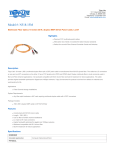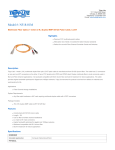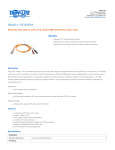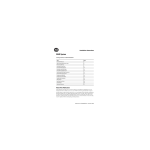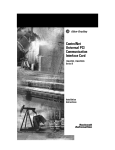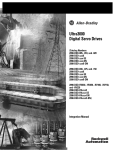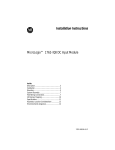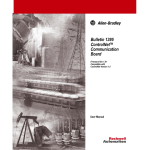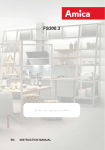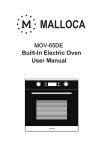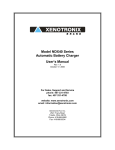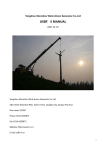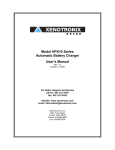Download ControlNet Daughtercards Installation Instructions
Transcript
Installation Instructions ControlNet Daughtercards Catalog Numbers 1788-CNF, 1788-CNFR Inside . . . For See Page Important User Information 2 Environment and Enclosure 3 European Hazardous Location Approval 4 North American Hazardous Location Approval 3 North American Hazardous Location Approval 5 About the Daughtercards 6 Set the Node Address 6 Install the Card 8 Connect the Card to the Network 8 Connect to the Network Using a Fiber Cable 9 Wire the Fiber Module for Zipcord Operation 9 Connect to the Network Using a 1786-CP Cable 11 Troubleshoot the Daughtercards 13 Related Publications 15 Technical Support 16 Specifications 17 31154 Publication 1788-IN005B-EN-P - October 2005 2 ControlNet Daughtercards Important User Information Solid state equipment has operational characteristics differing from those of electromechanical equipment. Safety Guidelines for the Application, Installation and Maintenance of Solid State Controls (Publication SGI-1.1 available from your local Rockwell Automation sales office or online at http://literature.rockwellautomation.com) describes some important differences between solid state equipment and hard-wired electromechanical devices. Because of this difference, and also because of the wide variety of uses for solid state equipment, all persons responsible for applying this equipment must satisfy themselves that each intended application of this equipment is acceptable. In no event will Rockwell Automation, Inc. be responsible or liable for indirect or consequential damages resulting from the use or application of this equipment. The examples and diagrams in this manual are included solely for illustrative purposes. Because of the many variables and requirements associated with any particular installation, Rockwell Automation, Inc. cannot assume responsibility or liability for actual use based on the examples and diagrams. No patent liability is assumed by Rockwell Automation, Inc. with respect to use of information, circuits, equipment, or software described in this manual. Reproduction of the contents of this manual, in whole or in part, without written permission of Rockwell Automation, Inc., is prohibited. Throughout this manual, when necessary, we use notes to make you aware of safety considerations. WARNING IMPORTANT ATTENTION Identifies information about practices or circumstances that can cause an explosion in a hazardous environment, which may lead to personal injury or death, property damage, or economic loss. Identifies information that is critical for successful application and understanding of the product. Identifies information about practices or circumstances that can lead to personal injury or death, property damage, or economic loss. Attentions help you identify a hazard, avoid a hazard, and recognize the consequences. SHOCK HAZARD Labels may be located on or inside the equipment (for example, drive or motor) to alert people that dangerous voltage may be present. BURN HAZARD Labels may be located on or inside the equipment (for example, drive or motor) to alert people that surfaces may be dangerous temperatures. Publication 1788-IN005B-EN-P - October 2005 ControlNet Daughtercards 3 Environment and Enclosure ATTENTION This equipment is intended for use in a Pollution Degree 2 industrial environment, in overvoltage Category II applications (as defined in IEC publication 60664-1), at altitudes up to 2000 meters without derating. This equipment is considered Group 1, Class A industrial equipment according to IEC/CISPR Publication 11. Without appropriate precautions, there may be potential difficulties ensuring electromagnetic compatibility in other environments due to conducted as well as radiated disturbance. This equipment is supplied as open-type equipment. It must be mounted within an enclosure that is suitably designed for those specific environmental conditions that will be present and appropriately designed to prevent personal injury resulting from accessibility to live parts. The interior of the enclosure must be accessible only by the use of a tool. Subsequent sections of this publication may contain additional information regarding specific enclosure type ratings that are required to comply with certain product safety certifications. NOTE: See NEMA Standards publication 250 and IEC publication 60529, as applicable, for explanations of the degrees of protection provided by different types of enclosure. Also, see the appropriate sections in this publication, as well as the Allen-Bradley publication 1770-4.1, Industrial Automation Wiring and Grounding Guidelines, for additional installation requirements pertaining to this equipment. Prevent Electrostatic Discharge ATTENTION This equipment is sensitive to electrostatic discharge, which can cause internal damage and affect normal operation. Follow these guidelines when you handle this equipment: • • • • • • Touch a grounded object to discharge potential static. Wear an approved grounding wriststrap. Do not touch connectors or pins on component boards. Do not touch circuit components inside the equipment. If available, use a static-safe workstation. When not in use, store the equipment in appropriate static-safe packaging. Publication 1788-IN005B-EN-P - October 2005 4 ControlNet Daughtercards European Hazardous Location Approval European Zone 2 Certification (The following applies when the product bears the EEx marking.) This equipment is intended for use in potentially explosive atmospheres as defined by European Union Directive 94/9/EC. The LCIE (Laboratoire Central des Industries Electriques) certifies that this equipment has been found to comply with the Essential Health and Safety Requirements relating to the design and construction of Category 3 equipment intended for use in potentially explosive atmospheres, given in Annex II to this Directive. The examination and test results are recorded in confidential report No. 28 682 010. Compliance with the Essential Health and Safety Requirements has been assured by compliance with EN 50021. IMPORTANT This equipment is not resistant to sunlight or other sources of UV radiation. The secondary of a current transformer shall not be open-circuited when applied in Class I, Zone 2 environments. Equipment of lesser Enclosure Type Rating must be installed in an enclosure providing at least IP54 protection when applied in Class I, Zone 2 environments. This equipment shall be used within its specified ratings defined by Allen-Bradley. Provision shall be made to prevent the rated voltage from being exceeded by transient disturbances of more than 40% when applied in Class I, Zone 2 environments. Publication 1788-IN005B-EN-P - October 2005 ControlNet Daughtercards 5 North American Hazardous Location Approval The following information applies when operating this equipment in hazardous locations: Informations sur l’utilisation de cet équipement en environnements dangereux: Products marked “CL I, DIV 2, GP A, B, C, D” are suitable for use in Class I Division 2 Groups A, B, C, D, Hazardous Locations and nonhazardous locations only. Each product is supplied with markings on the rating nameplate indicating the hazardous location temperature code. When combining products within a system, the most adverse temperature code (lowest “T” number) may be used to help determine the overall temperature code of the system. Combinations of equipment in your system are subject to investigation by the local Authority Having Jurisdiction at the time of installation. Les produits marqués “CL I, DIV 2, GP A, B, C, D” ne conviennent qu’à une utilisation en environnements de Classe I Division 2 Groupes A, B, C, D dangereux et non dangereux. Chaque produit est livré avec des marquages sur sa plaque d’identification qui indiquent le code de température pour les environnements dangereux. Lorsque plusieurs produits sont combinés dans un système, le code de température le plus défavorable (code de température le plus faible) peut être utilisé pour déterminer le code de température global du système. Les combinaisons d’équipements dans le système sont sujettes à inspection par les autorités locales qualifiées au moment de l’installation. WARNING EXPLOSION HAZARD • Do not disconnect equipment unless power has been removed or the area is known to be nonhazardous. • Do not disconnect connections to this equipment unless power has been removed or the area is known to be nonhazardous. Secure any external connections that mate to this equipment by using screws, sliding latches, threaded connectors, or other means provided with this product. • Substitution of components may impair suitability for Class I, Division 2. • If this product contains batteries, they must only be changed in an area known to be nonhazardous. AVERTISSEMENT RISQUE D’EXPLOSION – • Couper le courant ou s’assurer que l’environnement est classé non dangereux avant de débrancher l'équipement. • Couper le courant ou s'assurer que l’environnement est classé non dangereux avant de débrancher les connecteurs. Fixer tous les connecteurs externes reliés à cet équipement à l'aide de vis, loquets coulissants, connecteurs filetés ou autres moyens fournis avec ce produit. • La substitution de composants peut rendre cet équipement inadapté à une utilisation en environnement de Classe 1, Division 2. • S’assurer que l’environnement est classé non dangereux avant de changer les piles. Publication 1788-IN005B-EN-P - October 2005 6 ControlNet Daughtercards About the Daughtercards The 1788-CNF or 1788-CNFR ControlNet network daughtercard architecture defines a common hardware and software interface that several different network interface cards will support. This lets products that are designed to support the network daughtercard option support several Rockwell Automation networks. You can install the daughtercard in any host device that supports the ControlNet daughtercard. IMPORTANT The host device must provide a suitable power source according to the product specifications. The ControlNet network requires at least one module that can store parameters and configure the network with those parameters upon start-up. This module is called a keeper since it keeps the network configuration. The daughtercard keeps the network parameters at any legal node address (01 to 99). Multiple devices on any one network can act as the network keeper. Each device capable of being the network keeper acts to back up the current keeper. This backup function is automatic and requires no action on your part. IMPORTANT With these cards, the non-volatile keeper data is erased when you perform a firmware update. Set the Node Address You must set two switch assemblies to configure the daughtercard with its unique network address. These switches are read at powerup to establish the network address of the card. Publication 1788-IN005B-EN-P - October 2005 ControlNet Daughtercards I/O Status LED Channel A Connector NAP Module Status LED 7 Node Address Switches 1788-CNF Network Status Indicators (A and B) 1788-CNFR 10’s Channel A Connector Channel B Connector 0’s Network Status Indicators (A and B) 31155 Set the node address to a value between 1 and 99. For optimum throughput, assign addresses to your ControlNet nodes in a sequential order starting with 01. Node address 00 is not a valid ControlNet address. You should only use node address 00 if the product that uses the ControlNet daughtercard has the ability to set the node address using the host device interface. This feature is typically used on products that do not provide easy customer access to the node address switches. If you set the node address switch to 00, it lets the host in which the daughtercard resides set the node address, rather than letting the daughtercard read the node address from the switch settings. Publication 1788-IN005B-EN-P - October 2005 8 ControlNet Daughtercards Install the Card Due to wide variation in available host devices, we cannot provide specific installation instructions in this document. For instructions on how to install the daughtercard in a host device, refer to the user manual for the particular host device. WARNING If you insert or remove the card while host power is on, an electrical arc can occur. This could cause an explosion in hazardous location installations. Be sure that power is removed or the area is nonhazardous before proceeding. 42822 42823 Connect the Card to the Network IMPORTANT Before you install your fiber-based network, refer to the ControlNet Fiber Media Planning and Installation Guide, publication CNET-IN001. After you have installed the card, connect it to the network. You must connect the card to the network using an approved ControlNet fiber cable such as: Cable Assembly Cat. No. 10 m 1786-FS10 20 m 1786-FS20 60 m 1786-FS60 100 m 1786-FS100 200 m 1786-FS200 300 m 1786-FS300 Publication 1788-IN005B-EN-P - October 2005 ControlNet Daughtercards 9 For more fiber cable options, refer to the ControlNet Fiber Media Planning and Installation Guide, publication CNET-IN001. Connect to the Network Using a Fiber Cable 1. Remove and save the protective caps from the ControlNet daughtercards. 2. Connect the fiber cable connector to the module’s connector. 2 1 42821 Wire the Fiber Module for Zipcord Operation IMPORTANT To prevent inadvertent reversal of the trunk cable connections (resulting in incorrect status displays), check the drop cable for a label indicating the attached cable before you make your connection. The zipcord uses a duplex cable. Duplex cables use a single cable that contains two separate fibers, one for transmit and one for receive. ATTENTION Under certain conditions, viewing the optical port may expose the eye to hazard. When viewed under some conditions, the optical port may expose the eye beyond the maximum permissible exposure recommendations. Publication 1788-IN005B-EN-P - October 2005 10 ControlNet Daughtercards To wire the module: 1. Hold down the latch and insert the Channel A zipcord connector into the duplex socket until the pins and latch lock into place. 2. Make sure you insert the blue pin (receive) of the zipcord connector into the left Rx and the black pin (transmit) into the right Tx socket. If Your Network Supports Connect the Fiber Cable nonredundant media (1788-CNF or -CNFR) to the channel A connector on the module redundant media (1788-CNFR) from trunk-cable A to channel A on the 1788-CNFR and from trunk-cable B to channel B on the 1788-CNFR. (1) (channel B on the 1788-CNFR is not used.)(1) Recommended when using channel A for non-redundant media. ControlNet Network Topology Example Rx A 1786-RPA 1786-RPFS 1786-RPA 1786-RPFS 1786-RPA 1786-RPFS Tx CH1 CH1 CH2 Rx Rx Tx Fiber Segment 1 Tx Rx Fiber Segment 2 XT Terminator Tx CH2 Rx CH1 Tx Rx Tx CH2 Rx Tx Fiber Segment 3 XT terminator Coax Segment 2 Coax Segment 1 Example ControlNet Node ACN 42834 Example ControlNet Node IMPORTANT It is not necessary to install nodes on coax segments. If you are only using the repeaters to extend, then install a 75-ohm terminator (1786-XT) on the BNC coax connector on the fiber repeater adapter (1786-RPA). Do this to all repeaters that are not connected to coax segments. Publication 1788-IN005B-EN-P - October 2005 ControlNet Daughtercards 11 Connect to the Network Using a 1786-CP Cable IMPORTANT If you use a non-redundant cable system, all ControlNet devices must be on the same channel. We recommend channel A. Use the following wiring diagram to connect the programming terminal to the network using a 1786-CP cable. WARNING If you connect or disconnect the ControlNet network access port (NAP) cable with power applied to this module or any device on the network, an electrical arc can occur. This could cause an explosion in hazardous location installations. The 1786-CP cable can plug into any ControlNet product’s NAP to provide programming capability on the ControlNet network. A programming terminal connected through this cable is counted as a node and must have a unique address. Any ControlNet Interface Card 1786-CP Cable 31074-M ATTENTION Use the 1786-CP cable when you connect a programming terminal to the network through the NAP; using another cable could result in possible network failures or product damage. IMPORTANT The NAP is only available on the 1788-CNF card. It is not available on the 1788-CNFR card. Publication 1788-IN005B-EN-P - October 2005 12 ControlNet Daughtercards Wiring for the 1786-CP Connector Cable Connector 1 Connector 2 Wire Number Signal Mnemonic Signal Name Wire Number Signal Mnemonic Signal Name 1 ISO-GND Isolated Ground 1 ISO-GND Isolated Ground 2 N.C. No Connection 2 N.C. No Connection 3 PTTX-H Transmit Data High 3 PTRX-H Receive Data High 4 PTTX-L Transmit Data Low 4 PTRX-L Receive Data Low 5 PTRX-L Receive Data Low 5 PTTX-L Transmit Data Low 6 PTRX-H Receive Data High 6 PTTX-H Transmit Data High 7 N.C. No Connection 7 N.C. No Connection 8 ISO-GND Isolated Ground 8 ISO-GND Isolated Ground Daughtercard Performance Due to wide variation in available host devices, we cannot provide specific performance capabilities in this document. For information concerning host/daughtercard performance characteristics, refer to the user manual for the particular host device. Publication 1788-IN005B-EN-P - October 2005 ControlNet Daughtercards 13 Troubleshoot the Daughtercards Status indicators provide information about the card and the network when you are connected via the fiber connectors. The following definitions and tables outline the possible states, explain what each state means to you, and indicate what action you should take, if any, to correct that state. Definition of terms: • steady - indicator is on continuously in the defined state. • alternating - the two indicators alternate between the two defined states at the same time (applies to both indicators when viewed together); the two indicators are always in opposite states, out of phase. • flashing - the indicator alternates between the two defined states (applies to each indicator viewed independent of the other); if both indicators are flashing, they flash together, in phase. IMPORTANT Keep in mind that the module status indictor reflects the module state, for example, self-test, firmware update, normal operation but no connection established. The network status indicators, A and B, reflect network status. Remember that the host is able to engage in local messaging with the card although it is detached from the network. Therefore, the module status indicator is flashing green if the host has successfully started the card. Note, however, that until the host removes reset, all indicators on the daughtercard will remain off. Publication 1788-IN005B-EN-P - October 2005 14 ControlNet Daughtercards Indicator Color Off Probable Cause(s) • Check the power supply. • Host is faulted • Ensure that the daughtercard is firmly seated in the slot. • Host is holding daughtercard in reset Steady Red Major fault Flashing Firmware update in progress Red Node address switch change (Minor fault) Module Status (MS) Recommended Action • No power • Cycle power. If the indicator remains off, replace the daughtercard or the host. There is a hardware fault with the module. Cycle power. If the problem persists, replace the daughtercard. No action required (firmware update in progress). The daughtercard’s node address switches may have been changed since power-up. Change the node address switches back to the original setting. The module will continue to operate properly. Invalid module firmware Update module firmware with ControlFlash Update utility. Duplicate node address The daughtercard’s node address duplicates that of another device. Remove power, change the node address to a unique setting, then apply power. Node address switch set to 00 Host must set valid node address. Flashing No connections established Green No action is required. Steady Green No action is required. Connections established Flashing Self-test Red/ Green I/O Status Always (I/O) Off IMPORTANT The module is performing self-diagnostics. Wait briefly to see if problem corrects itself. If problem persists, check the host. If the daughtercard cannot communicate with the host, it may remain in self-test mode. No action is required. This indicator is on during the indicator portion of the self-tests. The Module Status and I/O Status indicators are only available on the 1788-CNF card. Publication 1788-IN005B-EN-P - October 2005 ControlNet Daughtercards Indicator A or B 15 Color Probable Cause Recommended Action Off Channel disabled Program network for redundant media, if required. Steady Green Normal operation No action is required. Flashing Green/Off Temporary network errors None, unit will self-correct. Node is not configured to go on line Make sure the configuration keeper node is present and working. Flashing Red/Off Media fault Check media for broken cables, loose connectors, missing terminators, etc. (viewed separately) If condition persists, refer to ControlNet Coax Media Planning and Installation Guide, publication CNET-IN002. No other nodes present on Add other nodes to the network. network Flashing Red/Green Incorrect network configuration Cycle power or reset unit. If fault persists, contact your Rockwell Automation representative or distributor. Off See the MS indicator for additional information No action is required or apply power. Steady Red Faulted unit Cycle power or reset unit. If fault persists, contact your Rockwell Automation representative or distributor. Alternating Red/Green Self-test No action is required. Alternating Red/Off Incorrect node configuration Check network address and other ControlNet configuration parameters. A and B (viewed together) Related Publications If you are connecting the card directly to a ControlNet network, you should also refer to the following publications. Catalog Number Publication Name Publication Number N/A ControlNet Fiber Media Planning and Installation Guide CNET-IN001 N/A ControlNet Coax Media Planning and Installation Guide CNET-IN002 N/A ControlNet Cable System Planning and Installation Guide Release Note 1786-6.2.1-RN1 Publication 1788-IN005B-EN-P - October 2005 16 ControlNet Daughtercards Catalog Number Publication Name Publication Number 1786-RPA ControlNet Modular Repeater Adapter Installation Instructions 1786-IN013 1786-RPFS ControlNet Modular Repeater Short-distance Fiber Module Installation Instructions 1786-IN012 1786-TPR, 1786-TPS, 1786-TPYR, 1786-TPYS ControlNet Coax Tap Installation Instructions 1786-5.7 Technical Support For additional troubleshooting information on the ControlNet Daughtercards, access Rockwell Automation’s technical support services at 440.646.3223 or at http://support.rockwellautomation.com. Publication 1788-IN005B-EN-P - October 2005 ControlNet Daughtercards 17 Specifications Operational Temperature Storage Temperature Relative Humidity Vibration Operating Shock Non-Operating Shock Emissions ESD Immunity Radiated RF Immunity Enclosure Type Rating Power Requirements(1) 1788-CNF 1788-CNFR Power Consumption 1788-CNF 1788-CNFR Power Dissipation 1788-CNF 1788-CNFR Weight Wiring Category(2) IEC 60068-2-1 (Test Ad, Operating Cold), IEC 60068-2-2 (Test Bd, Operating Dry Heat), IEC 60068-2-14 (Test Nb, Operating Thermal Shock): This product is suitable for application in equipment that is rated 0...60 °C (32...140 °F) max. It is accebtable for the ambient slot temperature immediately surrounding this product to reach 85 °C (185 °F) max IEC 60068-2-1 (Test Ab, Un-packaged Non-operating Cold), IEC 60068-2-2 (Test Bb, Un-packaged Non-operating Dry Heat), IEC 60068-2-14 (Test Na, Un-packaged Non-operating Thermal Shock): -40...85 °C (-40...185 °F) IEC 60068-2-30 (Test Db, Un-packaged Non-operating Damp Heat): 5...95% non-condensing IEC 60068-2-6 (Test Fc, Operating): 5 g @ 10...500 Hz IEC 60068-2-27 (Test Ea, Unpackaged Shock): 30 g IEC 60068-2-27 (Test Ea, Unpackaged Shock): 50 g CISPR 11: Group 1, Class A (with appropriate enclosure) IEC 61000-4-2: 6 kV contact discharges 8 kV air discharges IEC 61000-4-3: 10 V/m with 1 kHz sine-wave 80%AM from 30...1000 MHz 10 V/m with 200 Hz 50% Pulse 100%AM at 900 Mhz None (open-style) 5V dc @ 440 mA max 5V dc @ 450 mA max 2.20 W 2.25 W 2.20 W or 7.51 BTU/hr 2.25 W or 7.68 BTU/hr 0.1 kg (0.2 lb) 3 - on NAP (1) Note: To comply with UL and CSA restrictions, this equipment must be powered from a source compliant with the following: Class 2 or Limited Voltage/Current, as defined in UL 508 Seventeenth Edition Section 32; and Safety-Extra Low Voltage (SELV) as defined in CSA C22.1 no. 1010 Annex H (2) Use this Conductor Category information for planning conductor routing. Refer to Publication 1770-4.1, "Industrial Automation Wiring and Grounding Guidelines". Publication 1788-IN005B-EN-P - October 2005 18 ControlNet Daughtercards Certifications Certification Value Certifications(1) (when product is marked) UR CSA CSA CE C-Tick EEx CI (1) UL Recognized Component Industrial Control Equipment CSA Accepted Component for Process Control Equipment CSA Accepted Component for Process Control Equipment in Class I, Division 2 Group A,B,C,D Hazardous Locations European Union 89/336/EEC EMC Directive, compliant with: EN 50082-2; Industrial Immunity EN 61326; Meas./Control/Lab.,Industrial Requirements EN 61000-6-2; Industrial Immunity EN 61000-6-4; Industrial Emissions EN 61131-2; Programmable Controllers (Clause 8, Zone A & B) Australian Radiocommunications Act, compliant with: AS/NZS CISPR 11; Industrial Emissions European Union 94/9/EC ATEX Directive, compliant with: EN 50021; Potentially Explosive Atmospheres, Protection “n” (Zone 2) ControlNet Int'l conformance tested to ControlNet specifications See the Product Certification link at www.ab.com for Declarations of Conformity, Certificates, and other certification details. RSNetWorx for DeviceNet and DeviceLogix are trademarks of Rockwell Automation, Inc. Trademarks not belonging to Rockwell Automation are property of their respective companies. Publication 1788-IN005B-EN-P - October 2005 ControlNet Daughtercards 19 Notes: Publication 1788-IN005B-EN-P - October 2005 Rockwell Automation Support Rockwell Automation provides technical information on the web to assist you in using its products. At http://support.rockwellautomation.com, you can find technical manuals, a knowledge base of FAQs, technical and application notes, sample code and links to software service packs, and a MySupport feature that you can customize to make the best use of these tools. For an additional level of technical phone support for installation, configuration and troubleshooting, we offer TechConnect Support programs. For more information, contact your local distributor or Rockwell Automation representative, or visit http://support.rockwellautomation.com. Installation Assistance If you experience a problem with a hardware module within the first 24 hours of installation, please review the information that's contained in this manual. You can also contact a special Customer Support number for initial help in getting your module up and running: United States 1.440.646.3223 Monday – Friday, 8am – 5pm EST Outside United States Please contact your local Rockwell Automation representative for any technical support issues. New Product Satisfaction Return Rockwell tests all of its products to ensure that they are fully operational when shipped from the manufacturing facility. However, if your product is not functioning and needs to be returned: United States Contact your distributor. You must provide a Customer Support case number (see phone number above to obtain one) to your distributor in order to complete the return process. Outside United States Please contact your local Rockwell Automation representative for return procedure. ö Publication 1788-IN005B-EN-P - October 2005 Supersedes Publication 1788-IN005A-EN-P - March 2001 PN 957974-60 Copyright © 2005 Rockwell Automation, Inc. All rights reserved. Printed in the U.S.A.




















